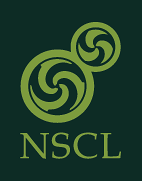How Does Sulfur-44 Get its Spin?
A measurement performed at NSCL provided new insights into the structure of the rare isotope sulfur-44, which has an excess of 12 neutrons as compared to the most abundant stable sulfur-32 isotope found in nature.
When the nucleus has a non-spherical (e.g., football-like) shape, it can exhibit collective motion, in which many protons and neutrons rotate in unison and the total angular momentum is built from many nucleonic contributions. Spinning states can also appear in weakly deformed nuclei by exciting relatively few nucleons. In many cases, such excitations are isomers, i.e., they decay with great difficulty.
The team of researchers led by the NSCL users from the Florida State University, studied the deformed magic nucleus sulfur-44 with the recoil-distance Doppler-shift technique using the state-of-the-art gamma-ray detection system GRETINA. To their surprise, the lifetime of the lowest observed 4+ excitation in this nucleus turned out to be far too long to be understood as a collective excitation having similar structure as in the lowest 0+ and 2+ states. This finding suggests that a nature of the 4+ level is closer to the limit of non-collective rotation. This is very unusual: while non-collective isomeric states are present in many heavy nuclei, the one found in sulfur-44 appears at a particularly low excitation energy and it has unusually low angular momentum. Several theoretical studies motivated by the puzzling data suggest that sulfur-44 has a variety of quantum states that not only differ in shape but also in their internal makeup.
A paper on this research was published in Physical Review Letters in January 2017.




